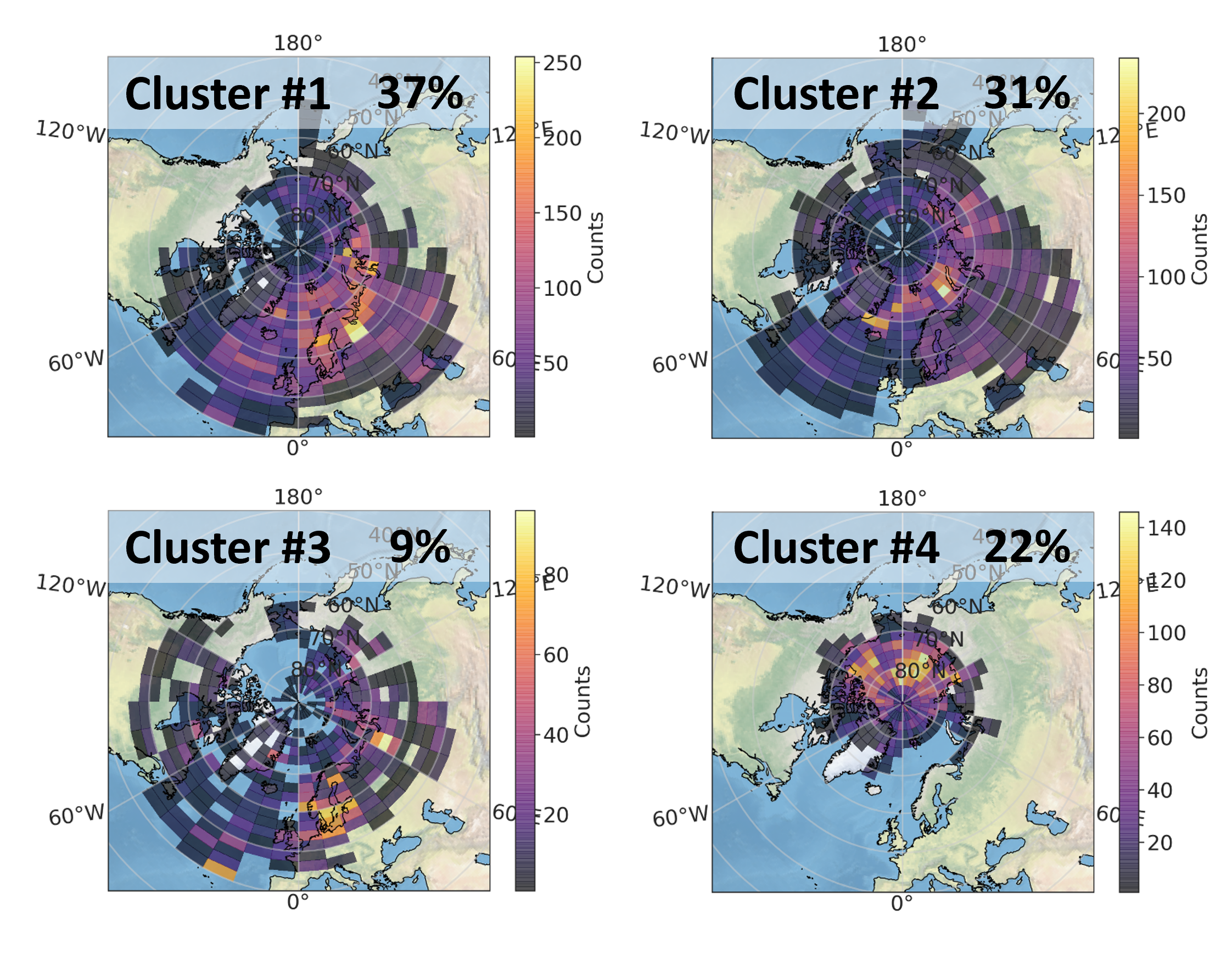Insights on sources and formation mechanisms of central arctic supercooled clouds
Submitter
Silber, Israel — Pacific Northwest National Laboratory
Area of Research
Cloud Processes
Journal Reference
Silber I and M Shupe 2022. "Insights on sources and formation mechanisms of liquid-bearing clouds over MOSAiC examined from a Lagrangian framework." Elementa: Science of the Anthropocene, 10(1), 10.1525/elementa.2021.000071.
Science

Figure 1. Density maps of airmass coordinates at their plausible source region (96–120 h backward in time) for each of the four back-trajectory clusters. The color scale represents counts in each 2.5° latitude×10.0° longitude grid cell. The percentage at the top of each panel denotes cluster occurrence relative to the full dataset. Image from authors.
We use the MOSAiC radiosonde data set to detect liquid-bearing cloud layers over full atmospheric columns and perform 5-day back-trajectory calculations for every detected cloud layer to examine cloud-generating airmasses. By clustering these airmass back-trajectories, we separate between airmass source regions such as the ice-covered Arctic and mid-latitude open water.
Impact
We find that moisture intrusions into the central Arctic typically result in multilayer liquid-bearing cloud structures and that more than half of multilayer profiles include overlying liquid-bearing clouds originating in different types of airmasses. We suggest that two-thirds of the clouds observed over MOSAiC that were associated with arctic air circulating over high sea-ice concentration regions were likely partially induced or augmented by open water patches and ice leads that moistened the associated airmasses. Finally, we postulate that arctic cloud formation via persistent radiative cooling of elevated stable subsaturated airmasses can occur frequently and may lead to a substantial cloud radiative impact on the surface.
Summary
Understanding arctic stratiform liquid-bearing cloud life cycles and properly representing these life cycles in models is crucial for evaluations of cloud feedbacks as well as the faithfulness of climate projections for this rapidly warming region. Examination of cloud life cycles typically requires analyses of cloud evolution and origins on short time scales, on the order of hours to several days. Measurements from the recent Multidisciplinary drifting Observatory for the Study of Arctic Climate (MOSAiC) expedition provide a unique view of the current state of the central Arctic over an annual cycle. Here, we detect liquid-bearing cloud layers over full atmospheric columns using the MOSAiC radiosonde measurement data set and examine their potential source origins by clustering back-trajectory calculations performed by the HYSPLIT model informed by ERA-5 reanalysis. We find that moisture intrusions into the central Arctic typically result in multilayer liquid-bearing cloud structures and that more than half of multilayer profiles include overlying liquid-bearing clouds originating in different types of airmasses. Finally, we conclude that arctic cloud formation via prolonged radiative cooling of elevated stable subsaturated airmasses circulating over the Arctic can occur frequently (up to 20% of detected clouds in the sounding data set) and may lead to a significant impact of ensuing clouds on the surface energy budget, including net surface warming in some cases.
Keep up with the Atmospheric Observer
Updates on ARM news, events, and opportunities delivered to your inbox
ARM User Profile
ARM welcomes users from all institutions and nations. A free ARM user account is needed to access ARM data.


















